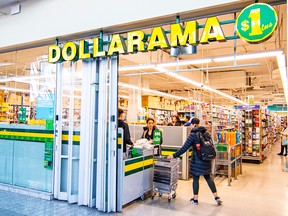High interest rates, inflation causing change in shopping habits that’s boosting discount stores’ sales
Article content
Searching “Dollarama finds” on TikTok pulls up thousands of videos of people showing off the latest deals and unexpected products they come across on the retailer’s shelves. The search query alone has more than 224 million views with users showing off $4 bamboo cutting boards and 330-millilitre cans of kombucha for $2.25.
Advertisement 2
Article content
In the videos, creators often remark about what a surprise it was to see the quality and kinds of products they found at the dollar store, but it’s really the price that grabs most people’s attention.
Article content
High interest rates coupled with persistent inflation are causing Canadians to change their shopping habits, a trend that might continue as the economy teeters on recession, some experts say, and that’s helping discount retailers boost sales even if consumers are trying to spend less.
Dollarama Inc. on June 7 said same-store sales, a metric that excludes figures from newly opened stores, grew by more than 17 per cent year over year for the quarter ended April 30. The number of transactions grew 15 per cent and the average size of those transactions ticked up 1.4 per cent in the quarter, suggesting customers are buying more products compared to last year. Total sales at the Montreal-based company reached $1.29 billion, up nearly 21 per cent.
Advertisement 3
Article content
Chief executive Neil Rossy told analysts there is a “strong demand” for consumables, which includes groceries as well as items meant to be used and replaced quickly, such as paper, plastics, foils, cleaning supplies, basic health and beauty care products and pet food.

“While we continue to experience strong demand for consumables in the context of persistent inflationary pressures, we are also seeing strength across our seasonal and general merchandise category,” he said.
The macroeconomic environment is pushing consumers to “change address” and shop around at dollar stores and discount grocers, such as Loblaw Cos. Ltd.’s No Frills, for basic necessities in order to seek relief from high prices, said Sylvain Charlebois, director of the Agri-Food Analytics Lab at Dalhousie University.
Article content
Advertisement 4
Article content
“Food sales at dollar stores were up 15 per cent … last year,” he said, adding that sales at discount grocers increased eight per cent. “The food inflation phenomena is finally hitting consumers and shopping habits have shifted quite rapidly in the last 12 months or so.”
Consumer prices have remained stubbornly high, rising 4.4 per cent on an annual basis in April after steadily declining each month since peaking in June 2022 at 8.1 per cent.
The food inflation phenomena is finally hitting consumers and shopping habits have shifted quite rapidly
Sylvain Charlebois
Despite the Bank of Canada raising interest rates at the fastest pace on record last year — bringing the policy rate to 4.5 per cent this January from near zero — the Governing Council determined that monetary policy wasn’t restrictive enough to bring supply and demand in balance and inflation back to its two-per-cent target, prompting the central bank to raise the rate again on June 7 to 4.75 per cent.
Advertisement 5
Article content
Shoppers’ changing habits boil down to sticker shock across all categories and with the central bank’s rate hikes eating into people’s budgets, it’s easier to trade down — meaning shoppers opt for smaller and cheaper items than they’d typically buy — on food items than it is with housing, Charlebois said.
“While people are being asked to pay more to make sure they have a roof over their head, they’re adjusting by retreating at the grocery store,” he said.
In general, consumer behaviour tends to be sticky, said Rod Duclos, an associate professor of marketing at Western University’s Ivey Business School in London, Ont. But a “shock,” and a period of high inflation could be considered one, can change their shopping habits, such as experimenting with novel, less expensive options like private labels.
Advertisement 6
Article content

“Along the way, some consumers will find that these alternatives aren’t bad — in fact, some may be just as good or better — which will cause them to form new purchasing habits and stick to them, even after inflation goes away,” he said. “However, in categories where the alternatives experimented are seen as inferior, or in categories where there are fewer alternatives, I suspect consumers will return to their prior habits once they can afford them again.”
In the short term, though, it’s clear Dollarama is gaining market share as a result of higher prices elsewhere for the types of products it sells. It’s also doing better than its competitors, including companies based in the United States that also operate in Canada, said Brian Yarbrough, an analyst at Edward D. Jones & Co. LP.
Advertisement 7
Article content
“No one else in the Canadian environment … is posting (Dollarama’s) kind of comps,” he said. “(Management) probably feels like the consumer will remain cautious.”
Dollarama appeals to consumers looking to trade down because it offers smaller sizes and cheaper price points, he added. The highest-priced items at the retailer are $5 before tax, a price point the company introduced last year to restock shelves with products that had been priced out due to supply-chain woes and increased input costs, as well as to expand its offerings to include items such as yoga mats.
Other discounters are also experiencing increased sales, though some are seeing difficulties ahead as consumers trade down.
For example, Tennessee-based Dollar General Corp. on June 1 said same-store sales increased 1.6 per cent in its first quarter ended May 5. But its shares dropped 20 per cent after the company said it expects earnings to fall eight per cent on the year.
Advertisement 8
Article content
“Unfortunately, our customers are saying they’re having to rely more on food banks, savings, credit cards,” chief executive Jeff Owen said on a call with analysts.
Meanwhile, Washington-based Costco Wholesale Corp. reported that comparable store sales in Canada increased more than seven per cent on an adjusted basis, which excludes impacts from gasoline prices and foreign exchange rates, for its third quarter ended May 7. In the U.S., Costco’s same-store sales ticked up 1.8 per cent.
Richard Galanti, Costco’s chief financial officer, told analysts on a May 25 conference call that the company historically sees members shift purchases from beef to poultry in times of recession.
“We have seen some of that now,” he said. “We saw some (members) switch even to some canned products — canned chicken and canned tuna, things like that.”
Advertisement 9
Article content

The reason Dollarama has outperformed competitors could be because of COVID-19, Yarbrough said. In the U.S., the government was laxer with mandatory lockdowns compared to Canada, whose economy was reopened later in 2021.
“The guys in the United States were open … and they were considered essential retailers,” he said, adding that U.S. competitors posted strong comparisons through the pandemic. “They’re having difficulty comping over those comps.”
Also, high- and middle-income consumers south of the border tend to get rid of some, but not all discretionary spending in trying economic times whereas lower-income shoppers struggle more, Yarbrough said. Lower-income Americans received stimulus cheques during the pandemic, but they mainly spent the money on non-essential products and didn’t save as much, he said.
Advertisement 10
Article content
“Inflation started ramping up and they ran out of those savings,” he said. “That definitely exaggerated the situation.”
On an aggregate level in Canada, the numbers show that consumer spending overall has been resilient even as the central bank has hiked interest rates, Clair Fan, economist at Royal Bank of Canada, said.
I don’t think it’s going to end soon, I can tell you that
Sylvain Charlebois
RBC card-spending data showed retail spending (minus car purchases) rose in April after slowing for four consecutive months. But breaking the numbers down shows that spending on discretionary goods has dropped while spending on discretionary services, particularly local entertainment, recreation and dining out, has remained steady.
Anecdotally, Fan said she is seeing more evidence of consumers trading down to make up for budget increases elsewhere.
Advertisement 11
Article content
“It only makes sense because it is quite a pretty drastic increase for a lot of households when it comes to what they’re paying to service their mortgages,” she said.
RBC said the average Canadian is currently using 15 per cent of their take-home income to pay off debt, whether that’s mortgages, credit cards or other loan types.
Part of the resilience in consumer spending has to do with the impact COVID-19 has had on higher-income households compared to lower-income ones, Fan said.
Lower-income households weren’t able to save as much during the pandemic and were more vulnerable to job insecurity, which has caused them to increasingly rely on credit cards to fund basic and necessary purchases.
-

Dollarama sales climb as shoppers search for discounts
-

Grocer, bank reputations tumble in Canada
-

Company wants to turn Mexico’s dollar store industry upside down
It’s uncertain for how long Canadians might have to trade down, both Fan and Charlebois said. The Bank of Canada ended its brief pause on raising interest rates and economists are calling for a recession to possibly hit in the second half of this year.
“I don’t think it’s going to end soon, I can tell you that,” Charlebois said.
• Email: bbharti@postmedia.com | Twitter: biancabharti
Article content
Canadians flocking to discount retailers in search of deals
2023-06-13 14:41:35







Comments
Postmedia is committed to maintaining a lively but civil forum for discussion and encourage all readers to share their views on our articles. Comments may take up to an hour for moderation before appearing on the site. We ask you to keep your comments relevant and respectful. We have enabled email notifications—you will now receive an email if you receive a reply to your comment, there is an update to a comment thread you follow or if a user you follow comments. Visit our Community Guidelines for more information and details on how to adjust your email settings.
Join the Conversation